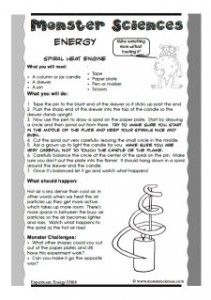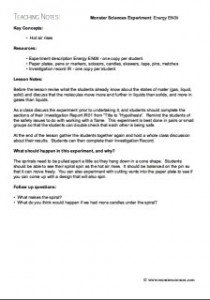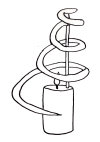A great hands on simple machines experiment about the simplest of all machines – an inclined plane. Students will genuinely be able to see the difference an inclined plane makes to the amount of effort needed to raise a load and will be able to compare a long inclined plain with a shallow slope with a short, steep inclined plane.
 |
 |
An engineering science experiment about inclined planes.
What you will need:
• 4 large books
• 1 long ruler and 1 shorter ruler
• 4 elastic bands
• 1 ziplock plastic bag
• 1 cup of dry rice
What you will do:
- Link the elastic bands together in a chain.
- Pour the rice into the ziplock bag and seal it. Then turn the bag on its end and tie one end with the last elastic band in the chain.
- Place three books in a pile. Put your finger through the elastic band at the other end of the chain and lift it up to the height of the top of the book stack. Have your partner measure how long the elastic band chain had to stretch.
- Now lie the long ruler down so that the spare book is propped against the end and the middle of the ruler is resting on the top edge of the book stack. It should be a
fairly short, steep slope. - Put the bag of rice at the bottom of the slope and pull on the other end of the elastic band chain to lift the bag to the height of the top of the book stack. Once
again your partner should measure how long the elastic band has become. - Now set up the long ruler so that one end is still against the book and the other end is resting on top of the book stack. It should be a long, gentle slope. Once again
use the inclined plain to lift the rice to the height of the book stack and measure the stretch of the elastic bands.
What should happen:
The ramps you have made with the long ruler are inclined planes, which are actually a type of simple machine because they make a job easier. It takes less effort to lift something on a short steep inclined plane and even less effort for a long inclined plane that has a more gradual slope.
Monster Sciences:
• Make a list of inclined planes you might find in everyday use, or inclined planes used in history.
Teaching Notes: Monster Sciences Experiment: Engineering EG08
Teaching Notes: Monster Sciences Experiment: Engineering EG08
Key Concepts:
• Simple machine – inclined plane
Resources:
• Experiment description Engineering EG08 – one copy per student.
• books, long and short rulers, ziplock bags, rice, elastic bands
Lesson Notes:
Begin the lesson by placing a bag of rice on the floor and asking your students what they would do to get it from the floor to the table. Once they have given you some ideas, ask them what they would do if instead of rice the bag held something amazingly heavy, so heavy no human being could lift it. Your students may suggest working together to lift it. If they do, praise their spirit of cooperation but ask them if they thought you’d get very tired if you had to lift hundreds of them every day.
Explain that in order to make difficult tasks like that easier, we use machines. And some machines really are very simple. Today’s experiment is one of the simplest – an inclined plane. You will need to explain that to be a “machine” it just needs to make a job easier, it doens’t need a motor or moving parts.
Demonstrate how to tie the elastic band around the bag of rice so that it is firm enough not to slip off during the experiment. You might also like to demonstrate how to tie the elastic bands onto each other to make a string.
Before beginning the experiment students should complete the sections of their Investigation Report IR01 from ”Title to “Hypothesis”.
At the end of the lesson gather the students together again and discuss their results.
What should happen in this experiment, and why?
Students should be able to describe how the elastic bands stretched quite a lot when the load was lifted straight up onto the books but less on the steep inclined plane and even less on the longer, less steep plane. This is because the inclined plane makes lifting a load from one level to another easier. A short steep plane provides a smaller advantage but takes less distance, whereas the longer inclined plane with the more gentle slope is easier but the load must travel a longer distance.
Follow up questions:
• Is you had to lift a load a very long way up but didn’t have room for one very long inclined plane, what could you do? [use a series of short inclined planes]
• Where can you see inclined planes in the school or where we live?



